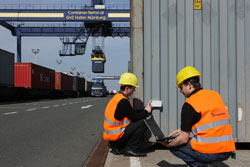Analyzing energy potential

Researchers attaching a data logger to a shipping container. © Fraunhofer IIS<br>
The freight train races through the landscape at high speed, the train cars clattering along the tracks. The cars are rudely shaken, back and forth. The rougher the tracks, the more severe the shaking. This vibration delivers enough energy to charge small electronic equipment: this is how the sensors that monitor temperatures in refrigerator cars, or GPS receivers, can receive the current they need to run.
Vibration replaces batteries
Experts refer to this underlying technology as “energy harvesting“, where energy is derived from everyday sources such as temperature or pressure differences, air currents, mechanical movements or vibrations. But is this really enough to supply electronic microsystems? The answer is provided by a data logger that is also installed on board, a product by the Fraunhofer Institute for Integrated Circuits. This compact system analyzes and characterizes the potential of usable energy – in this case, the oscillations created during the ride. It measures key parameters of the source of the vibrations, such as the amplitude and the frequency spectrum of acceleration.
“We can use the data collected to design vibration converters, such as the piezoelectric generators, to feed the sensors, radio transmission receivers, tracking systems and other low-power-consuming devices with enough energy to power them,“ explains the IIS group manager and engineer, Dr. Peter Spies. “The tracking systems in use to date run on just a battery. These batteries need constant replacement, but that involves a lot of effort and expense. Thanks to energy harvesting, we can replace the batteries and wiring.“
Logistics processes are not the only candidates, however. The energy “harvested“ can be used for a great many other applications as well – to charge heart-rate monitors, sensors in washing machines and production plants, or measurement systems in cars to measure the air pressure in tires.
The elements of the data logger include an acceleration sensor, a GPS module, a micro-controller, an SD card and a WiFi interface. The sensor measures the freight train‘s acceleration along three axes. At the same time, the GPS module determines the vehicle‘s position and stores the data along with the acceleration values on the SD card. These parameters can be used to pinpoint the train‘s speed and the amount of energy available to it. “That way, we can fine-tune the energy converter and tailor it to the application involved,“ the researcher adds.
The data logger is already in use in freight cars, trucks and machinery. Spies and his team are currently working to develop a complete tracking system that includes not only a GSM module and a GPS receiver but also a vibration converter that turns mechanical energy into electrical energy. The researchers are showcasing a prototype of the IIS data logger at the Sensor+Test 2012 trade fair, May 22-24 in Nuremberg, in Hall 12, Booth 202.
Media Contact
All latest news from the category: Trade Fair News
Newest articles

Silicon Carbide Innovation Alliance to drive industrial-scale semiconductor work
Known for its ability to withstand extreme environments and high voltages, silicon carbide (SiC) is a semiconducting material made up of silicon and carbon atoms arranged into crystals that is…

New SPECT/CT technique shows impressive biomarker identification
…offers increased access for prostate cancer patients. A novel SPECT/CT acquisition method can accurately detect radiopharmaceutical biodistribution in a convenient manner for prostate cancer patients, opening the door for more…

How 3D printers can give robots a soft touch
Soft skin coverings and touch sensors have emerged as a promising feature for robots that are both safer and more intuitive for human interaction, but they are expensive and difficult…





















